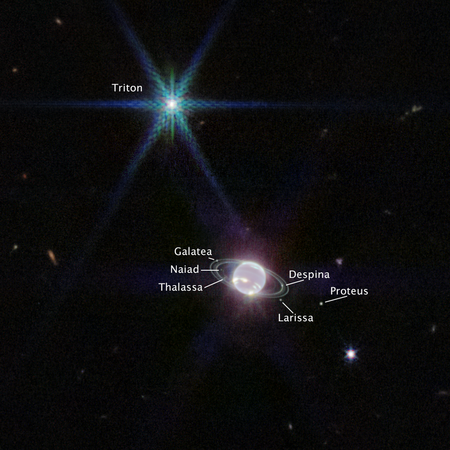Moons of Neptune facts for kids

The planet Neptune has 16 known moons. They are named after water gods and creatures from ancient Greek stories. The biggest moon is Triton. It was found by William Lassell in 1846, just 17 days after Neptune was discovered!
It took over 100 years to find the second moon, Nereid, in 1949. Then, 40 more years passed before Proteus was found in 1989. Proteus is Neptune's second largest moon.
Neptune's moons are split into two main groups: regular and irregular. The regular moons are the seven inner moons. They travel in nearly perfect circles around Neptune's middle. The other nine moons, including Triton, are irregular. They usually have tilted and stretched-out paths far from Neptune. Triton is special because it orbits close to Neptune, but its path is backward and tilted.
Neptune's Moons: A Closer Look
Here is a list of Neptune's moons. They are ordered from the fastest to the slowest in their orbits around Neptune. Moons that are "irregular" (meaning they were likely captured by Neptune's gravity) are shown with a colored background.
The paths of irregular moons can change a lot. This is because of the pull from Neptune and the Sun. So, the orbital details for these moons are averages over a very long time. Triton is the only moon big enough to be perfectly round. Its name is in bold below.
| Number | Name | Image | Size (km) |
Distance from Neptune (km) |
Orbital Period (days) |
Discovery Year |
Discoverer | Group |
|---|---|---|---|---|---|---|---|---|
| III | Naiad | 60 | 48224 | +0.2944 | 1989 | Voyager Science Team | inner | |
| IV | Thalassa | 81 | 50074 | +0.3115 | 1989 | Voyager Science Team | inner | |
| V | Despina | 156 | 52526 | +0.3346 | 1989 | Voyager Science Team | inner | |
| VI | Galatea | 175 | 61953 | +0.4287 | 1989 | Voyager Science Team | inner | |
| VII | Larissa | 194 | 73548 | +0.5555 | 1981 | Reitsema et al. | inner | |
| XIV | Hippocamp | 35 | 105283 | +0.9500 | 2013 | Showalter et al. | inner | |
| VIII | Proteus | 420 | 117646 | +1.1223 | 1989 | Voyager Science Team | inner | |
| I | Triton | 2705 | 354759 | −5.8769 | 1846 | Lassell | Irregular | |
| II | Nereid | 357 | 5504000 | +360.14 | 1949 | Kuiper | Irregular | |
| IX | Halimede | 62 | 16590100 | −1879.30 | 2002 | Holman et al. | Irregular | |
| XI | Sao | 44 | 22239300 | +2918.70 | 2002 | Holman et al. | Sao Group | |
| S/2002 N 5 | 38 | 23365200 | +3141.26 | 2002 | Holman et al. | Sao Group | ||
| XII | Laomedeia | 42 | 23502300 | +3175.65 | 2002 | Holman et al. | Sao Group | |
| X | Psamathe | 40 | 47611900 | −9149.87 | 2003 | Sheppard et al. | Neso Group | |
| XIII | Neso | 60 | 49871600 | −9796.67 | 2002 | Holman et al. | Neso Group | |
| S/2021 N 1 | 25 | 50623600 | −10017.93 | 2021 | Sheppard et al. | Neso Group |
Images for kids
-
Orbital diagram of the orbital inclination and orbital distances for Neptune's rings and moon system at various scales. Notable moons and rings are individually labeled. Open the image for full resolution.
See also
 In Spanish: Satélites de Neptuno para niños
In Spanish: Satélites de Neptuno para niños








